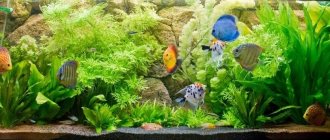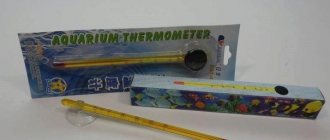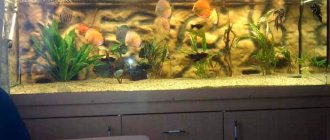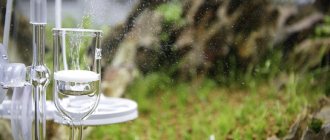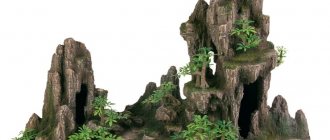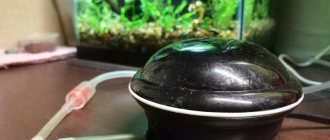SPECIFY THE DIMENSIONS OF THE AQUARIUM AND THE HEIGHT OF THE GROUND LAYER BY MOVING THE SLIDERS
1 liter of soil is not always equal to 1 kg. So the weight of the soil directly depends on its density. Some manufacturers indicate the volume in liters on packages of aquarium soil.
Add some soil to the estimated amount of soil. This supply will help replenish the soil lost when cleaning the aquarium; in addition, additional soil will be needed when decorating an aquarium with a relief bottom.
The amount of aquarium soil is determined in volume (liters). It is important to understand that 1 liter of soil does not always = 1 kg. The weight of the soil depends on its density. Many manufacturers produce aquarium soil in packages on which the volume is written in liters.
It is difficult to imagine an aquarium with plants and no soil. It not only serves as a substrate and source of nutrients for plants, but also performs a decorative function. The soil serves as a background for fish and plants, and replacing it can change the entire composition of the aquarium. Depending on the type of soil, it contains saprophytic microorganisms, which, in the course of their life activity, convert dead organic matter (putrefactive bacteria, blowfly larvae, mold fungi) into nutrients.
This substance is quickly absorbed by plant roots, promoting their active growth.
The importance of choosing the right soil
The substrate at the bottom of the aquarium performs the following functions:
- is a biological filter;
- participates in the nitrogen cycle of ammonia breakdown into nitrides and nitrates;
- mineralizes and changes carbonate hardness of water;
- becomes a habitat for bacteria and microorganisms;
- provides rooting and nutrition of plants;
- creates comfortable conditions for keeping fish;
- helps decorate the landscape of the aquarium.
Photo gallery of aquariums with different soils:
It is important to know that the selection of soil directly depends on the type of aquarium. Standard, collection, species, biotope, nano, mixed types are used to observe fish. They focus on plants in a Dutch pond, open decorated or paludarium.
Before choosing a substrate, carefully study information about the natural habitat of pets. Do they like to burrow into the flooring, how do they feed and reproduce? The water hardness and acidity levels acceptable for keeping fish are specified.
They find out how plants planned for planting in a pond receive nutrition and take root. If they extract useful substances from water, and the soil is needed only for fixation, then there is no need for a two-layer substrate.
Plan the overall appearance of the aquarium. The color of the material covering the bottom should favorably emphasize the color of the inhabitants of the reservoir and be combined with the vegetation and size of the container.
Select soil consisting of rounded particles. There are gaps between them sufficient to ensure water exchange. The fraction of the flooring must correspond to the behavioral characteristics of the fish and the root system of plants. Bottom currents will saturate them with oxygen and prevent the release of harmful substances such as methane and hydrogen sulfide, which affect the acidity of the water.
Necessary equipment
In a 100-liter aquarium for its normal functioning it is necessary to install:
- Filter. It can be internal or external. For a 100-liter tank it is more convenient to use an internal filter. Its power should be sufficient for such a volume.
- Compressor. This device is necessary to supply air inside the tank and saturate the water with oxygen. Having a compressor is especially important when there is overcrowding. The device is equipped with a sprayer, which is lowered to the bottom of the reservoir.
- Heater. It is necessary to maintain the water temperature at a given level. It should be placed in the corner of the tank or at the bottom. It is advisable to have an air sprayer located nearby, which will help mix the water and establish a uniform temperature throughout the entire volume.
- Thermometer. It is necessary to control the water temperature in the reservoir. The thermometer should be placed on the wall approximately in the middle of its height in the part of the aquarium farthest from the heater. Before installation, you must verify the accuracy of its readings by comparing it with any other thermometer.
- Illuminated lid. The aquarium with fish is closed with a lid so that overly active individuals do not jump out. The herbalist does not require a lid. A lamp with a lamp of a suitable spectrum sufficient for a 100-liter volume of power is placed above the surface of the water.
- Special cabinet. May be required to install an aquarium if there is no suitable furniture in the room. Aquarium cabinets have a flat surface and are massive enough to support the weight of a tank filled with water. They are often equipped with shelves and drawers for storing aquarium accessories.
Calculation of the amount of soil
Internet users perform this operation using an aquarium calculator. It calculates the required volume and mass taking into account the type of material used.
For a square meter of substrate 5 cm thick:
| Filler type | Density, kg/l | Volume, l | Weight, kg |
| Quartz sand | 1.4 | 50 | 70 |
| Marble chips | 2.7 | 135 | |
| Random ground | 1.4 | 70 | |
| Aragonite sand | 1.66 | 83 |
Calculate the required volume by multiplying the length of the base of the container by its width and the height of the flooring layer. Decimeters are used as a unit of measurement for ease of calculation. The density value of the material fraction is multiplied by the resulting volume and the required mass of the substrate is found out. They buy soil with a reserve of 10%.
Required layer height
The height of the soil layer in the aquarium can vary from 2 to 10 cm . With a small number of plants, a minimum 2 cm bottom cover is sufficient. When simulating natural sea or river relief, creating a landscape of coral reefs, the thickness of the soil reaches 5 - 10 cm, in addition to its aesthetic function, maintaining the ecological balance of a closed volume.
If the soil is too thick, it can cause acidification of the water. An excess of soil materials is harmful to the aquarium, as well as a lack or absence of it.
If there are a large number of plants, the insufficient thickness of the substrate will become an insurmountable obstacle to the development and fixation of the root system of the aquarium flora.
Types of soil mixtures for aquariums
For bottom flooring use:
- rocks of natural origin: quartz, sand, gravel;
- substrates obtained by mechanical or chemical action on natural components;
- artificially produced nutrient mixtures for aquarium plants.
The bottom of the aquarium is covered with sand: river, quartz, aragonite, black and sea.
This material is obtained by crushing minerals, corals, and also by washing out rocks. Available in white, cream, yellow, black. This is a neutral substrate; only aragonite chips change the water hardness.
There are:
- dusty – less than 1 mm;
- fine-grained – less than 2 mm;
- medium-grained – about 2.5 mm.
Coarse sand is mainly used - up to 3 mm.
For the lower nutrient layer, vermiculite and laterite are used as mixture components. Both substances contain iron compounds, which are so necessary for the full development of plants. Ferrum concentration in water up to 0.1 mg/l stimulates fish growth and ensures normal development of eggs. Exceeding the dose above 0.2 mg/l leads to the death of pets. Before starting the aquarium, the amount of iron content is checked with a special test. You can buy it at a pet store.
To decorate a pond, use soil made of natural black quartz or granite. If the stone is artificially colored, then a non-fading material is selected.
White filler is made from marble, granite or quartz chips. It looks impressive, but requires careful care and frequent cleaning. The color of the fish fades against such a background.
Artificial soil is made from glass, polymers and plastic. Bright, glowing pebbles will decorate the aquarium, but will not become a nutritional source for plants.
What filler is unacceptable?
Significant characteristics are the shape of soil particles and their size:
- A substrate consisting of elements with sharp edges or chips is strictly not to be used. They cause injury to fish, negatively affect the rooting of plants, and complicate the process of cleaning the bottom.
- Flooring laid from fractions of different sizes loses its ability to “breathe” and becomes waterlogged. The process of decay of organic matter is activated with the release of toxic substances that are harmful to fish.
- Substrate particles smaller than 3 mm impede water exchange. They cause acidification of the bottom flooring.
- Garden soil is not used as a component of nutrient soil when landscaping an aquarium. They are afraid of uncontrolled algae growth: blue-green algae, filamentous algae.
- Glass pebbles are not able to accumulate useful substances and become the basis for the residence of microorganisms and plants. It scatters light, which irritates the fish and ultimately negatively affects the health of the pets.
- Expanded clay is a natural, porous and very light material. Recommendations for its use are contradictory. Select a fraction up to 1 cm, boil it, and remove floating particles. The use of this material is considered inappropriate due to: accumulation of harmful substances in the porous structure;
- movement of expanded clay by water flows;
- creating a cloudy slurry when fish rummage through it.
Plants
Plants should also be selected based on the behavior and food preferences of aquatic organisms. Some species of fish are herbivores and will pluck young shoots and leaves of delicate representatives of the underwater flora. When keeping benthic species that like to dig, you should choose plants with a strong root system.
The placement of plants is chosen depending on their size. Species with long stems and leaves are planted in the corners and along the back wall, slow-growing species of medium height (cryptocoryne, anubias, ferns) are planted in the middle ground; creeping and ground cover plants (mosses, staurogyne, sitnaria, etc.) are planted along the front glass.
On a note! Beginners are not recommended to purchase greens that require complex care: special lighting, regular fertilization, carbon dioxide supply.
Do-it-yourself soil for an aquarium
Bottom preparation depends on the type of ecosystem.
For a species aquarium, a single-layer neutral substrate is suitable. The size of its particles must correspond to the lifestyle of the fish. Therefore, the main work in creating soil will be dividing it into fractions. The semi-finished product is searched for in the beds and shallows of nearby reservoirs, and several places are examined at once. Materials of different compositions may lie very close by.
Geological sieves are being used. A similar design can be made independently. Holes are made in tin cans of suitable size: 3-5 mm; 5-8 mm. They receive a set of devices for separation into three fractions. An ordinary kitchen colander replaces a 3 mm sieve.
Prepare a bowl of warm water. A device with a dose of soil is lowered into it and they begin to shake sharply from side to side. A serving of filler should be the size of a glass. This makes the washing process easier. It’s good if a little clay remains, it will enrich the substrate layer with microelements.
The fine fraction is left for small aquariums with long-stemmed plants. Large particles are used in arranging the habitat of large fish.
Before laying, the bottom flooring is disinfected in a solution of potassium permanganate or chloramine. They practice calcining the substrate in the oven.
For the development of aquarium flora, two-layer coatings are used.
Materials for soil
When making homemade mixtures, the following materials are used.
Clay
It is recommended to use this component in gray color. It is believed that there is no excess humus and iron in it.
Peat
Organic source. Use granulated or compressed in tablet form. Excess humus leads to acidification of the soil.
Coconut fiber
Its cutting has a medium rate of decomposition with a constant, slow release of organic matter.
Sorbent
Vermiculite is used to retain nutrients in the soil and prevent the rapid dissolution of microelements in water.
Coal
The use of this component leads to a complete replacement of the soil after 8-10 months. It is capable of not only neutralizing the breakdown products of organic compounds, but also returning substances back into solution. Therefore, the feasibility of using this component is questionable.
Other inhabitants
In addition to fish, other freshwater aquatic organisms can be placed in a 60-liter aquarium. This volume is suitable for keeping aquarium shrimp of any type. The most common shrimp species found in captivity are neocaridines, Amano, and crystal. They are unpretentious, undemanding to water parameters and get along well with their relatives.
Also, a volume of 60 liters can be stocked with snails. Popular species include ampularia, neretin, helen, melanium. Snails have an attractive appearance and free the aquarium from food leftovers that have not been eaten by fish. They get along well with other aquatic organisms, but can eat their eggs.
Features of laying soil in an aquarium
The selected material is thoroughly washed without the use of detergents and poured in a layer of 4-7 cm. It is easier to siphon a thin layer of flooring, but you have to take into account the strength of the root system of plants if they are not planted in special pots. Laying the soil at an angle is not practical, nor is trying to make patterns from materials of different colors. Bottom currents, work on cleaning the flooring, and the activity of fish at the bottom of the aquarium will reduce the effort to zero.
If you want to build a slide, use large stones. The mound is planted with plants with strong roots, giving it shape. Such structures are secured with Java moss, using it as a ground cover.
Driftwood and decorative elements are pre-soaked and antiseptics are used. Place objects directly on the bottom of the aquarium, immersing the base in the ground and giving them stability.
When laying two-layer soil, use coarse sand or pebbles with a fraction of 3 mm. A layer of 2-3 cm is laid on a nutrient mixture of peat, vermiculite, coconut fiber, clay, with the addition of a bacterial activator. The total height of the flooring reaches 8 cm.
How much sand is needed?
For 30 liter container
It is necessary to calculate the weight of average sand for a layer of 3 cm: Height of the aquarium - C = 30; (density value of average sand from the table is 0.00165 kg/cm3) m = 1000·0.00165·2·30:30 = 3 kg.
For 50
The height of the aquarium is C=40. We calculate the weight of small granite chips for a layer of 2 cm: (density value of small granite chips from the table is 0.0017 kg/cm3) m = 1000 0.0016 2 50:40 = 4 kg.
For 100
It is necessary to calculate the weight of thin sand for a layer of 2 cm. The height of the aquarium is C = 47; (density value of fine sand from the table is 0.0017 kg/cm3) m = 1000·0.0017·2·100:47 = 7.2 kg.
For 120
The height of the aquarium is C=60. We calculate the weight of large pebbles for a layer of 6 cm: (density value of large pebbles from the table is 0.0014 kg/cm3) m = 1000·0.0014·6·120:60 = 16.8 kg.
For 200
The height of the aquarium is C = 90. We calculate the weight of large granite pebbles for a layer of 8 cm: (the density value of large granite pebbles is 0.0013 kg/cm3) m = 1000 0.0013 8 200:90 = 23 kg.
Aquarium soil care
The bottom substrate is cleaned as it gets dirty. In a specialized store, they purchase equipment to perform this operation - a siphon. The main parts of all types of mud cleaners are a plastic funnel (flask) with a soft hose attached to it. A rubber bulb or electric motor facilitates the process of pumping out water when removing detritus from the soil surface.
If necessary, make the siphon yourself:
- Cut off the top part with the neck of the plastic bottle, put a suitable flexible tube on it and wrap the connection with tape.
- Fill the siphon with water, clamp the end of the hose with your finger, and lower the funnel into the aquarium.
- Lower the tube into the container to drain the liquid and, removing the clamp, start the process of cleaning the bottom.
- By pressing the funnel to the surface of the substrate, the water flow is regulated. They move smoothly along the flooring, plunging into the ground in circles, and perform deep cleaning.
Partial water changes are combined with bottom treatment. The volume of liquid drained will depend on the diameter of the hose of the selected siphon model. The work is carried out quickly enough so as not to drain more than 20-25% of the total amount of water. To do this, you need to move the funnel in time. The transparent tube of the dirt cleaner, 1 cm wide, makes it easy to monitor the quality of cleaning of a 100 liter aquarium.
The frequency of these actions depends on the volume of the tank, the size and number of fish, and the density of planting. The interval between cleanings is 1-2 weeks, determining the timing for a specific type of ecosystem. It is not recommended to clean the soil in herbalists.
